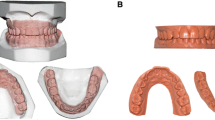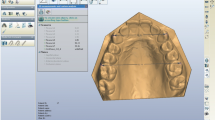Abstract
Aim
The purpose of the present study was to evaluate the accuracy and reproducibility of measurements made on digital models created using an intraoral color scanner compared to measurements on dental plaster models.
Methods
This study included impressions of 28 volunteers. Alginate impressions were used to make plaster models, and each volunteers’ dentition was scanned with a TRIOS Color intraoral scanner. Two examiners performed measurements on the plaster models using a digital caliper and measured the digital models using Ortho Analyzer software. The examiners measured 52 distances, including tooth diameter and height, overjet, overbite, intercanine and intermolar distances, and the sagittal relationship. The paired t test was used to assess intra-examiner performance and measurement accuracy of the two examiners for both plaster and digital models. The level of clinically relevant differences between the measurements according to the threshold used was evaluated and a formula was applied to calculate the chance of finding clinically relevant errors on measurements on plaster and digital models.
Results
For several parameters, statistically significant differences were found between the measurements on the two different models. However, most of these discrepancies were not considered clinically significant. The measurement of the crown height of upper central incisors had the highest measurement error for both examiners. Based on the interexaminer performance, reproducibility of the measurements was poor for some of the parameters.
Conclusions
Overall, our findings showed that most of the measurements on digital models created using the TRIOS Color scanner and measured with Ortho Analyzer software had a clinically acceptable accuracy compared to the same measurements made with a caliper on plaster models, but the measuring method can affect the reproducibility of the measurements.
Zusammenfassung
Zielsetzung
Genauigkeit und Reproduzierbarkeit von Messungen auf digitalen Modellen, die nach intraoralen Farbscans hergestellt wurden, sollten verglichen werden mit der Genauigkeit und der Reproduzierbarkeit von auf Gipsmodellen vorgenommenen Messungen.
Methoden
An der vorliegenden Studie nahmen 28 freiwillige Probanden teil. Zur Anfertigung von Gipsmodellen dienten Alginatabdrücke. Die Bezahnung jedes Probanden wurde mit dem TRIOS Color Intraoralscanner gescannt. Alle Modelle wurden von 2 Untersuchern vermessen: die Gipsmodelle mit einer digitalen Schieblehre, die digitalen Modelle mit der Software Ortho Analyzer. Vermessen wurden 52 Strecken, darunter Zahndurchmesser und –höhe, Overjet, Overbite, intercanine Distanz, der Intermolarenabstand sowie die sagittale Beziehung. Um die Intra-Untersucher-Performance und die Messgenauigkeit für die Untersucher und die beiden Modelle zu bestimmen, diente der gepaarte t-Test. Das Ausmaß klinisch relevanter Unterschiede zwischen den Messungen, je nach Schwellenwert, wurde evaluiert. Klinisch relevanter Messfehler an beiden Modellarten wurden berechnet.
Ergebnisse
Für etliche Parameter zeigten sich statistisch signifikante Differenzen zwischen den Messungen auf den 2 unterschiedlichen Modelltypen, von denen die meisten allerdings als klinisch nicht signifikante Diskrepanzen angesehen wurden. Der größte Messfehler beider Untersucher zeigte sich bei der Messung der Kronenhöhe der oberen zentralen Inzisiven. Auf Grundlage der Inter-Untersucher-Performance erwies sich Reproduzierbarkeit der Messungen für einige Parameter als unzureichend.
Schlussfolgerungen
Die Daten zeigen, dass die Genauigkeit der meisten Messungen mit der Software Ortho Analyzer auf digitalen Modellen, die unter Verwendung des Systems TRIOS Color Scanner erstellt wurden, im Vergleich mit der Genauigkeit der Schieblehremessungen an Gipsmodellen klinisch akzeptabel ist. Allerdings kann die verwendete Messmethode die Reproduzierbarkeit der Messungen beeinflussen.





Similar content being viewed by others
References
Abizadeh N, Moles DR, O’Neill J et al (2012) Digital versus plaster study models: how accurate and reproducible are they? J Orthod 39:151–159
Akyalcin S, Cozad BE, English JD et al (2013) Diagnostic accuracy of impression-free digital models. Am J Orthod Dentofacial 144:916–922
Bootvong K, Liu Z, McGrath C et al (2010) Virtual model analysis as an alternative approach to plaster model analysis: reliability and validity. Eur J Orthod 32:589–595
Cuperus AM, Harms MC, Rangel FA et al (2012) Dental models made with an intraoral scanner: a validation study. Am J Orthod Dentofac. Orthop 142:308–313
de Waard O, Rangel FA, Fudalej PS et al (2014) Reproducibility and accuracy of linear measurements on dental models derived from cone-beam computed tomography compared with digital dental casts. Am J Orthod Dentofacial Orthop 146:328–336
Fleming PS, Marinho V, Johal A (2011) Orthodontic measurements on digital study models compared with plaster models: a systematic review. Orthod Craniofac Res 14:1–16
Flugge TV, Schlager S, Nelson K et al (2013) Precision of intraoral digital dental impressions with iTero and extraoral digitization with the iTero and a model scanner. Am J Orthod Dentofacial Orthop 144:471–478
Garino F, Garino GB (2002) Comparison of dental arch measurements between stone and digital casts. World J Orthod 3:250–254
Goracci C, Franchi L, Vichi A et al (2016) Accuracy, reliability, and efficiency of intraoral scanners for full-arch impressions: a systematic review of the clinical evidence. Eur J Orthod 38:422–428
Grunheid T, McCarthy SD, Larson BE (2014) Clinical use of a direct chairside oral scanner: an assessment of accuracy, time, and patient acceptance. Am J Orthod Dentofacial Orthop 146:673–682
Grunheid T, Patel N, De Felippe NL et al (2014) Accuracy, reproducibility, and time efficiency of dental measurements using different technologies. Am J Orthod Dentofacial Orthop 145:157–164
Hurt AJ (2012) Digital technology in the orthodontic laboratory. Am J Orthod Dentofac Orthop 141:245–247
Kau CH, Littlefield J, Rainy N et al (2010) Evaluation of CBCT digital models and traditional models using the Little’s Index. Angle Orthod 80:435–439
Kim J, Heo G, Lagravere MO (2014) Accuracy of laser-scanned models compared to plaster models and cone-beam computed tomography. Angle Orthod 84:443–450
Leifert MF, Leifert MM, Efstratiadis SS et al. (2009) Comparison of space analysis evaluations with digital models and plaster dental casts. Am J Orthod Dentofacial Orthop 136:16 e1–4 (discussion 16)
Mullen SR, Martin CA, Ngan P et al (2007) Accuracy of space analysis with emodels and plaster models. Am J Orthod Dentofac Orthop 132:346–352
Naidu D, Freer TJ (2013) Validity, reliability, and reproducibility of the iOC intraoral scanner: a comparison of tooth widths and Bolton ratios. Am J Orthod Dentofac Orthop 144:304–310
Pandis N (2012) Sample calculations for comparison of 2 means. Am J Orthod Dentofac Orthop 141:519–521
Santoro M, Galkin S, Teredesai M et al (2003) Comparison of measurements made on digital and plaster models. Am J Orthod Dentofac Orthop 124:101–105
Stevens DR, Flores-Mir C, Nebbe B et al (2006) Validity, reliability, and reproducibility of plaster vs digital study models: comparison of peer assessment rating and Bolton analysis and their constituent measurements. Am J Orthod Dentofac Orthop 129:794–803
Tomassetti JJ, Taloumis LJ, Denny JM et al (2001) A comparison of 3 computerized Bolton tooth-size analyses with a commonly used method. Angle Orthod 71:351–357
Torassian G, Kau CH, English JD et al (2010) Digital models vs plaster models using alginate and alginate substitute materials. Angle Orthod 80:474–481
van der Meer WJ, Andriessen FS, Wismeijer D et al (2012) Application of intra-oral dental scanners in the digital workflow of implantology. PLoS One 7:e43312
White AJ, Fallis DW, Vandewalle KS (2010) Analysis of intra-arch and interarch measurements from digital models with 2 impression materials and a modeling process based on cone-beam computed tomography. Am J Orthod Dentofacial Orthop 137:456 e1–9 (discussion 456–457)
Wiranto MG, Engelbrecht WP, Nolthenius HET et al (2013) Validity, reliability, and reproducibility of linear measurements on digital models obtained from intraoral and cone-beam computed tomography scans of alginate impressions. Am J Orthod Dentofac Orthop 143:140–147
Zilberman O, Huggare JA, Parikakis KA (2003) Evaluation of the validity of tooth size and arch width measurements using conventional and three-dimensional virtual orthodontic models. Angle Orthod 73:301–306
Acknowledgements
We would like to thank the Coordination of Improvement for Higher Education Personnel (CAPES) for the scholarship supporting the first author’s PhD during the development of this study, and the companies Barra Laudo and Compass for enabling the intraoral scanning of the volunteers of this study. We also would like to thank the Department of Orthodontics and Craniofacial Biology of Radboud University Nijmegen Medical Centre (Nijmegen, The Netherlands) for the support and especially Ewald Bronkhorst for the statistical analysis.
Author information
Authors and Affiliations
Corresponding author
Ethics declarations
Conflict of interest
L.T. Camardella, H. Breuning, and O. de Vasconcellos Vilella declare that they have no competing interests.
All procedures performed in studies involving human participants were in accordance with the ethical standards of the institutional and/or national research committee and with the 1964 Helsinki declaration and its later amendments or comparable ethical standards. Informed consent was obtained from all individual participants included in the study.
Additional information
Leonardo Tavares Camardella: Pos Phd Student.
Rights and permissions
About this article
Cite this article
Camardella, L.T., Breuning, H. & de Vasconcellos Vilella, O. Accuracy and reproducibility of measurements on plaster models and digital models created using an intraoral scanner. J Orofac Orthop 78, 211–220 (2017). https://doi.org/10.1007/s00056-016-0070-0
Received:
Accepted:
Published:
Issue Date:
DOI: https://doi.org/10.1007/s00056-016-0070-0




